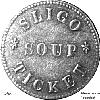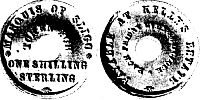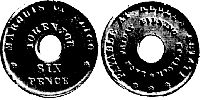| INDEX
| IRISH TOKENS
| Copyright ©
S.B.Woodside
1997-2011
Last update:-
15-Aug-11
barry.woodside@ic24.net
|
Non-Irish
Irish American
Marquis of Sligo
|
| Scroll through the data.
|
Co. Sligo (or possibly Westport, Co. Mayo?)
These tokens are now known to be from Jamaica,
but are included here because they were once
attributed to Ireland by Batty as follows.
TIN ONE SHILLING (Now known to be Jamaican)
1. O: + MARQUIS OF SLIGO + TOKEN FOR ONE SHILLING STERLING*
R: PAYABLE AT KELLY'S ESTATE + + + EACH FRIDAY
EVENg 6 O'CLOCK* (M.11). R.r.r.
TIN SIXPENCE (Now known to be Jamaican)
2. O: Similar, but STERLING omitted, value SIX PENCE
R: Similar, but EVENING instead of EVENg
(M.9). R.r.
TIN THREEPENCE (Now known to be Jamaican)
3. O: Similar, but without the star and crosses in the legend, value THREEPENCE
R: Similar, but a period instead of a star
after O'CLOCK (M.8«). R.
These three pieces have
holes in the centre, Mionnet 1, down in proportion. The
legends on the tokens very much resemble in character those
of Charleville Forest, Kings County.
"I much regret
that I am unable to give you any satisfactory information
about the family 'Tokens.' There is only a vague tradition
that, during the last 25 years of the eighteenth century and
the first 25 years of the nineteenth century, these were
issued in place of money. Those in the eighteenth century
would be in the name of Lord Monteagle, Viscount Westport, or
the Earl of Altamont, as the Marquisate was not created till
1800. We did not know that any of the tokens existed, and I
am much interested to hear that you have some"
- Earl of Altamont, heir to the Marquis of Sligo, to the
author, Jan. 22 1904.

Might this have been issued by the Marquis of
Sligo, in Westport, Co. Mayo?
This was recorded by Frazer as having been issued in the
late 18th C. to relieve the poor.
The following information, photos and the
illustrations of three of the tokens, are taken from Bob Lyall's
book
He kindly sent me a photocopy of the relevent
section for inclusion.

Howe Peter Browne, second Marquis of Sligo, born 1788, was
appointed the governor of Jamaica in 1834 with the special
objective of carrying out emancipation. Slavery was abolished on
1 August 1834 and temporary apprenticeship established which was
to last four years, when the slaves were to be given their total
freedom.

Kelly's Estate was in the Parish of St. Dorothy, now
merged with St. Catherine. It was described as a pen (cattle
estate) of 620 acres in 1816, but from 1817 it was described as a
sugar estate. By 1831 the estate employed 123 slaves and the
following year it sold 81 hogsheads of sugar and 40 puncheons of
rum. The Marquis owned the estate before 1834 when he arrived in
the island as Governor, but looked to sell it in 1836 when he
expected to leave the island. Sligo wished to rent Kelly's for 10
years but the potential client, Alexandre Bravo, wished to rent
for the duration of apprenticeship, i.e., until 1838. Mr. Bravo
did rent it and then, in 1842, he purchased both Kelly's and
Cocoa Walk (another estate owned by Lord Sligo) for £6000. The
lease documents describe the estate buildings as comprising a
mansion house, the overseer's house, the mill house with a 6 hp
steam engine, boiling house, curing house, trash house, still
house, etc., some of which buildings can be seen in the plate
which is from a painting of about 1834.
 The values expressed on the tokens are
in Sterling rather than in the local Currency rating. It would
seem the tokens were used to pay the emancipated slaves on a
weekly basis as was common practice on estates. The deeds of the
lease make no mention of an estate shop as one might have
expected, so either they were received by a local shop or Lord
Sligo cashed them into coin on Fridays in which case they were
perhaps given to the workers on completion of each task.
The values expressed on the tokens are
in Sterling rather than in the local Currency rating. It would
seem the tokens were used to pay the emancipated slaves on a
weekly basis as was common practice on estates. The deeds of the
lease make no mention of an estate shop as one might have
expected, so either they were received by a local shop or Lord
Sligo cashed them into coin on Fridays in which case they were
perhaps given to the workers on completion of each task.
 Whilst rates as high as 2/6 and even
3/4d Currency were paid on some estates at the time, planters
offered 7 1/2d Sterling in 1839 but this rate was refused by the
workers. So, it would seem that the 1/- token might have
represented a day's work for an adult male.
Whilst rates as high as 2/6 and even
3/4d Currency were paid on some estates at the time, planters
offered 7 1/2d Sterling in 1839 but this rate was refused by the
workers. So, it would seem that the 1/- token might have
represented a day's work for an adult male.




 The values expressed on the tokens are
in Sterling rather than in the local Currency rating. It would
seem the tokens were used to pay the emancipated slaves on a
weekly basis as was common practice on estates. The deeds of the
lease make no mention of an estate shop as one might have
expected, so either they were received by a local shop or Lord
Sligo cashed them into coin on Fridays in which case they were
perhaps given to the workers on completion of each task.
The values expressed on the tokens are
in Sterling rather than in the local Currency rating. It would
seem the tokens were used to pay the emancipated slaves on a
weekly basis as was common practice on estates. The deeds of the
lease make no mention of an estate shop as one might have
expected, so either they were received by a local shop or Lord
Sligo cashed them into coin on Fridays in which case they were
perhaps given to the workers on completion of each task. Whilst rates as high as 2/6 and even
3/4d Currency were paid on some estates at the time, planters
offered 7 1/2d Sterling in 1839 but this rate was refused by the
workers. So, it would seem that the 1/- token might have
represented a day's work for an adult male.
Whilst rates as high as 2/6 and even
3/4d Currency were paid on some estates at the time, planters
offered 7 1/2d Sterling in 1839 but this rate was refused by the
workers. So, it would seem that the 1/- token might have
represented a day's work for an adult male.